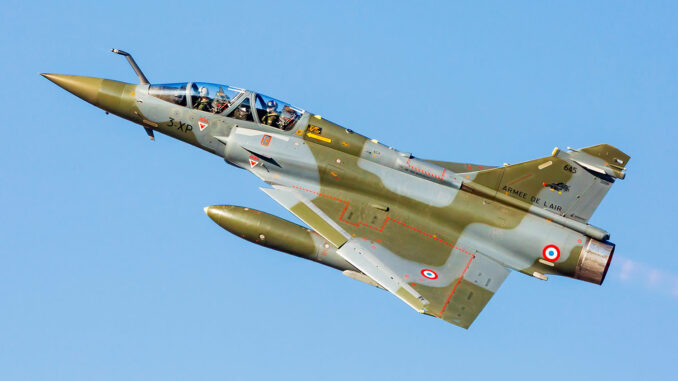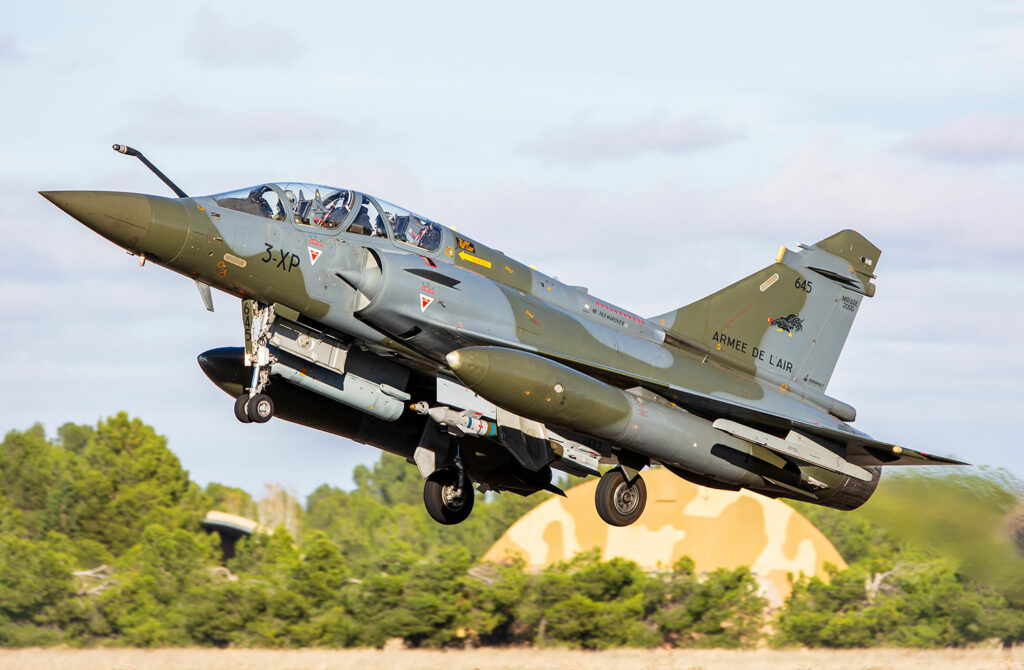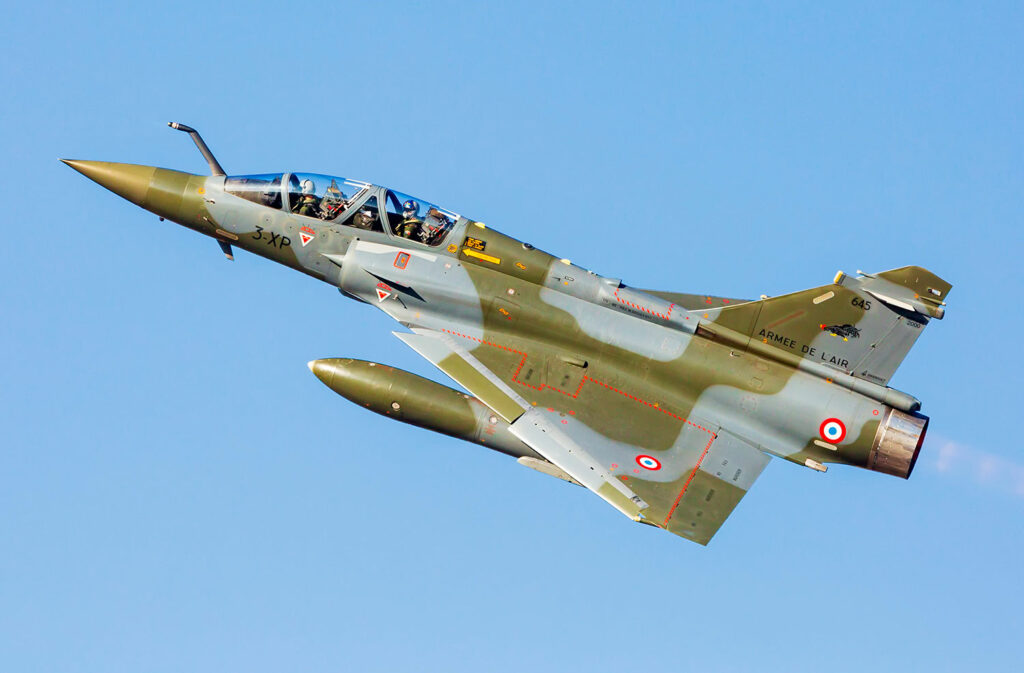
The modernized Mirage 2000D (DRMV) enters service with major improvements, extending its operational life until 2035.
The Mirage 2000D, a ground attack aircraft of the French Air and Space Force, is undergoing a mid-life renovation (RMV) transforming it into the Mirage 2000DRMV. This modernization includes advanced weaponry such as GBU-48/49/50 bombs, the MICA NG missile, and the TALIOS designation pod. The addition of a CC422 gun pod and a digital cockpit improves its operational capabilities. With an investment of 530 million euros, 50 aircraft will be modernized, extending their service until 2035, pending replacement by the Rafale and the future European fighter NGF.

Modernization of the Mirage 2000D: Objectives and scope of the RMV program
The Mirage 2000D Mid-Life Renovation (RMV) program aims to extend the operational life of this aircraft until 2035. Initially, 86 Mirage 2000Ds were produced between 1993 and 2001. The modernization now concerns 50 aircraft, reduced from the 71 initially planned, due to budgetary constraints. The total cost of the program is estimated at around 530 million euros, or around 10.6 million euros per aircraft.
Major improvements include the integration of new armaments, advanced navigation and targeting systems, and a completely updated cockpit. These modifications enable the Mirage 2000DRMV to remain competitive against modern threats and to integrate effectively into joint operations with NATO allies.
Armament improvements: Increased versatility
The Mirage 2000DRMV is now equipped with precision-guided munitions, including the GBU-48 (454 kg), GBU-49 (227 kg) and GBU-50 (907 kg) bombs, all of the Enhanced Paveway II type. These weapons offer increased precision thanks to laser and GPS guidance, enabling effective strikes with reduced collateral damage.
In addition, the aircraft can deploy the MICA NG infrared-guided air-to-air missile, replacing the Magic II. The MICA NG offers a greater range and better resistance to electronic countermeasures. The integration of the CC422 30 mm gun pod reinforces close support capabilities, a first for the Mirage 2000D.
Targeting and reconnaissance systems: The TALIOS pod
The TALIOS pod (Targeting Long-range Identification Optronic System) replaces the old ATLIS II, PDL CTS and Damocles pods. Developed by Thales, TALIOS offers target designation and tactical reconnaissance capabilities day and night. It generates high-resolution images in real time, transmitted via the Link 16 data link, improving coordination with allied forces.
This improvement allows the Mirage 2000DRMV to conduct reconnaissance and strike missions with increased precision, while reducing the time between target detection and engagement.
Modernization of the cockpit: Ergonomics and efficiency
The Mirage 2000DRMV cockpit has been completely modernized with the integration of multifunction digital displays and advanced software. This redesign improves the ergonomics and situational awareness of the pilot. The addition of the Thales Scorpion helmet-mounted display allows the pilot to view critical information directly in his field of vision, thus reducing the workload and increasing responsiveness on missions.
These improvements bring the Mirage 2000DRMV closer to the standards of modern fighter planes, facilitating the transition of pilots to more recent aircraft such as the Rafale.
Integration into the French defense strategy
The modernization of the Mirage 2000D is part of a broader strategy to maintain the operational capabilities of the Air and Space Force pending the arrival of the Rafale F4 and the future European NGF (Next Generation Fighter) fighter. The Mirage 2000DRMV will fill the capability gap and ensure the continuity of missions, particularly in external operations in the Middle East and Africa.
This pragmatic approach optimizes existing resources while preparing for the future, ensuring a smooth transition to next-generation combat systems.
Industrial and economic consequences
The RMV program benefits the French defense industry, in particular Dassault Aviation, Thales and Safran. It supports employment in the aeronautics sector and reinforces national expertise in the area of aircraft modernization. Furthermore, this initiative demonstrates France’s capacity to maintain and improve its weapon systems autonomously, thus reinforcing its technological sovereignty.
By extending the service life of the Mirage 2000D, France is optimizing its initial investment while ensuring an effective operational presence in current theaters of operation.

The future of the Mirage 2000DRMV
The Mirage 2000DRMV is expected to remain operational until 2035, which will give it a service life of over 40 years. This longevity is based on recent technical improvements, but also on a doctrine of use adapted to its capabilities. By keeping this aircraft in the active fleet, the French Air and Space Force guarantees uninterrupted operational coverage during the transition to new-generation platforms, including the Rafale F4 and the Next Generation Fighter (NGF) from the FCAS (Future Combat Air System) program.
The FCAS program, conducted in collaboration with Germany and Spain, is expected to enter service around 2040, which means that the Mirage 2000DRMV will have to remain a pillar of French air capabilities for another full decade. In the meantime, the Rafale F3R and F4 are expected to gradually take over. The current Rafale fleet numbers around 150 aircraft, with a target of 225 by 2030 according to the latest Defense White Paper.
The Mirage 2000DRMV, although technologically inferior to fifth-generation fighters, remains relevant in medium-intensity missions, close air support and conventional strikes, particularly in external theatres such as the Sahel or the Middle East. It also offers a strategic reserve capacity in the event of high-intensity conflict.
Its modularity also allows for the temporary reinforcement of certain fronts. For example, in the context of increased tension in Eastern Europe, it could be integrated into air policing missions in the Baltic States, or intervene in tactical support as in the Iniochos exercises in Greece or the Tactical Leadership Programme (TLP) in Spain.
Projection capacity and strategic use
The Mirage 2000DRMV operates from bases in mainland France (notably Nancy-Ochey), but also in forward deployment in the Middle East: H4 base in Jordan, or Al Dhafra in the United Arab Emirates. This deployment is part of a strategy of strategic permanence. At the international level, this shows that France is capable of maintaining an operational detachment continuously at a distance of more than 5,000 km from its borders, with older-generation aircraft that have been technologically adapted.
Precision strike missions against unconventional targets, such as the logistics depots of armed groups, communication systems or command positions, are suited to the Mirage 2000DRMV. Its ability to carry GBU-48 and GBU-49 bombs or the AASM missile allows strikes on fixed or mobile targets with a precision rate of less than 5 meters standard deviation.
Operational limitations to be anticipated
Despite these improvements, some components of the aircraft remain outdated. The Antilope 5 radar, for example, remains unchanged. This radar, although effective for low-altitude terrain tracking, does not meet modern standards for multi-target detection or electronic warfare. Similarly, the absence of active or passive stealth limits its use in environments heavily contested by modern air defenses such as the Russian S-400 or IRIS-T SL systems.
Finally, the number of modernized aircraft (50 units out of an initial fleet of 86 Mirage 2000Ds) mechanically limits the maneuvering mass. This figure represents approximately 24% of the total number of fighter planes in the Air Force, which is still sufficient for external operations such as Barkhane or Chammal, but not very suitable for a large-scale symmetrical confrontation.
Comparison with international standards
Worldwide, mid-life renovation programs for fourth-generation fighters are not uncommon. The United States has invested more than 4.5 billion dollars in the modernization of the F-16 Viper, including AESA radar, new cockpit, electronic warfare, etc. In comparison, the unit cost of modernizing the Mirage 2000DRMV, approximately 10.6 million euros, appears economically rational.
Similarly, Greece has modernized its Mirage 2000-5 Mk2 and F-16 to Block 72 standard. India continues to operate refurbished Mirage 2000Hs, which were used in the air strikes at Balakot in 2019. The operational efficiency of an aircraft therefore depends as much on its configuration as on the doctrine of use and the training of the crews.
In this context, the Mirage 2000DRMV remains a generation 4++ aircraft capable of operating with NATO standards: Link 16, precision munitions, real-time reconnaissance, electronic self-protection. This allows it to participate in interoperable missions without the need for fifth-generation platforms.
The Mirage 2000DRMV is a pragmatic transitional solution, meeting France’s tactical needs in a constrained budgetary context. Its technical modernization allows it to remain relevant until 2035, particularly for medium-intensity missions, targeted strikes, and close support.
War Wings Daily is an independant magazine.